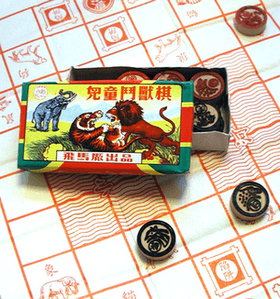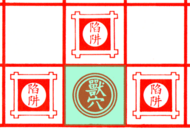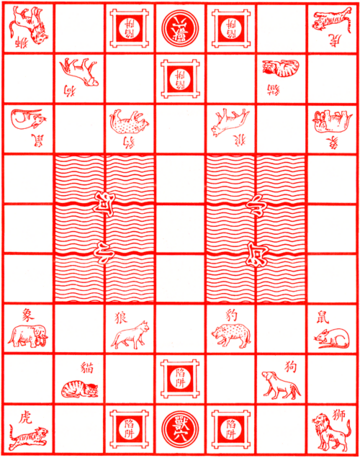Jungle (board game) facts for kids
| 鬥獸棋 (Dou Shou Qi) | |
|---|---|

A typical and inexpensive Jungle set with paper board, purchased at a Chinese stationery shop
|
|
| Genre(s) | Board game Abstract strategy game |
| Players | 2 |
| Setup time | 1–2 minutes |
| Playing time | 5–30 minutes |
| Random chance | None |
| Skill(s) required | Strategy, tactics, counting |
| Synonym(s) | Dou Shou Qi The Jungle Game Children's Chess Oriental Chess Animal Chess |
Jungle or Dou Shou Qi (which means "fighting animal game" in Chinese) is a fun board game from China. It's played on a 7x9 board and is very popular with kids in places like China and Japan. You might also hear it called The Jungle Game, Animal Chess, or Children's Chess.
Jungle is a strategy game for two players. Some people say it's like the Western game Stratego. However, Stratego is actually more similar to another Chinese game called Jun Qi (which means "army game").
Contents
What is the Jungle Game?
The Jungle game is played on a board that looks like a jungle. It has special spots like dens, traps, and rivers. Each player has eight animal pieces. These animals have different strengths or "ranks." Stronger animals can capture (or "eat") weaker or equally strong animals.
The goal is to move one of your animals into your opponent's den. If you do this first, you win! Another way to win is to capture all of your opponent's animal pieces.
How the Jungle Board Looks
The Jungle gameboard is usually made of paper. It has seven columns and nine rows of squares, making 63 squares in total. Pieces move from square to square, just like in chess.
The board shows pictures of eight animals on each side. These pictures show where each animal piece starts the game. After the game begins, these starting squares don't have any special meaning.
There are a few special areas on the Jungle board:
- Each player has one den square. This is in the middle of their first row. It is labeled in Chinese.
- Three traps are next to each den. They are on each side and in front of the den. These are also labeled in Chinese.
- Two rivers are in the middle of the board. Each river has 6 squares, forming a 2x3 rectangle. They are labeled with Chinese words for "river." There are also regular land squares along the edges and down the middle between the rivers.
Jungle Game Pieces
Each player has eight animal pieces. They are in different colors (blue versus red). Each animal has a different rank, meaning how strong it is. Here are the animals from strongest to weakest:
| Rank | Piece | |
|---|---|---|
| 8 | Elephant | Chinese: 象; pinyin: xiàng |
| 7 | Lion | Chinese: 獅; pinyin: shī |
| 6 | Tiger | Chinese: 虎; pinyin: hǔ |
| 5 | Leopard | Chinese: 豹; pinyin: bào |
| 4 | Wolf | Chinese: 狼; pinyin: láng |
| 3 | Dog | Chinese: 狗; pinyin: gǒu |
| 2 | Cat | Chinese: 貓; pinyin: māo |
| 1 | Rat | Chinese: 鼠; pinyin: shǔ |
Pieces start on the squares that show their animal's picture on the board.
How to Play Jungle: Rules
Movement Rules
Players take turns moving their pieces. The Blue player moves first. On your turn, you must move one of your pieces. All animals can move one square at a time. They can move horizontally (sideways) or vertically (up and down), but not diagonally.
An animal cannot move into its own den. Animals can move into and out of any trap square.
There are special rules for the water squares (rivers):
- Only the rat can go into the water squares.
- The lion and tiger can jump over a river. They can jump horizontally or vertically. They jump from a square on one side of the river to the first land square on the other side. If an enemy piece is on that square and is weaker or equal in rank, the lion or tiger can capture it as part of their jump.
- A lion or tiger cannot jump if a rat (of either color) is in any of the water squares they would jump over.
Capturing Rules
Animals capture opponent pieces by "eating" them. When you capture a piece, your attacking piece takes its place. The captured piece is removed from the game.
Generally, a piece can capture any enemy piece that has the same or a lower rank. But there are some important exceptions:
- The rat can capture an elephant. However, this can only happen if the rat is on a land square, not in the water. (Some stories say the rat wins by "running into its ear and gnawing into its brain"!)
- A rat that is in the water cannot be captured by any animal on land. So, a rat in the water can only be captured by another rat that is also in the water.
- If an animal moves into one of the opponent's trap squares, it becomes very weak. Any of the opponent's pieces can then capture it, no matter their rank. Once the trapped piece moves out of the trap, it gets its normal rank back.
Game Variations
Sometimes, people play Jungle with slightly different rules. Here are a few common variations:
- In some games, the elephant cannot capture the rat at all.
- Some players treat the lion and tiger as equally strong. This means they can capture each other.
- In some versions, the tiger is stronger than the lion.
- The leopard might be allowed to jump over rivers horizontally, but not vertically. It still cannot jump over a rat in the river.
- Some rules say that if an animal goes into a trap in its own area, an opponent's animal can still capture it, no matter their rank.
- There's a simpler version called Animal Checkers. It doesn't have traps or rivers. It only uses the rat, dog, tiger, and elephant pieces.
- Some players allow the dog to move onto water squares.
See also
 In Spanish: Dou Shou Qi para niños
In Spanish: Dou Shou Qi para niños





